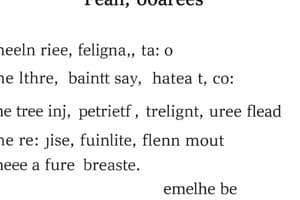Podcast
Questions and Answers
What does the speaker state is the main purpose of the 'There is nothing ~' structure?
What does the speaker state is the main purpose of the 'There is nothing ~' structure?
- To describe a problem or issue
- To state a personal opinion
- To describe the absence of something (correct)
- To express excitement about something
Which example BEST illustrates the phrase 'There is nothing to do here' in the context of the podcast?
Which example BEST illustrates the phrase 'There is nothing to do here' in the context of the podcast?
- A person feeling overwhelmed with tasks and needing a break.
- Someone at a party struggling to find a conversation.
- A student feeling bored in a classroom during a class discussion. (correct)
- A traveler arriving in a new city and looking for things to see.
According to the speaker, what is a key benefit of using the 'There is nothing ~' structure in English?
According to the speaker, what is a key benefit of using the 'There is nothing ~' structure in English?
- It sounds very formal and sophisticated in everyday speech.
- It helps learners avoid using common English vocabulary.
- It contributes to sounding more natural in English conversations. (correct)
- It adds complexity to conversations, making them more engaging.
Which of these options is NOT a practical example mentioned by the speaker for the phrase 'There is nothing ~'?
Which of these options is NOT a practical example mentioned by the speaker for the phrase 'There is nothing ~'?
Which phrase BEST demonstrates the speaker's tone in the 'Interactive Section' of the podcast?
Which phrase BEST demonstrates the speaker's tone in the 'Interactive Section' of the podcast?
What is the speaker's main objective in the 'Conclusion' section of the podcast?
What is the speaker's main objective in the 'Conclusion' section of the podcast?
What is the speaker's intention by saying 'There is nothing more to lose.'?
What is the speaker's intention by saying 'There is nothing more to lose.'?
In which section of the podcast does the speaker directly engage the listeners to actively participate?
In which section of the podcast does the speaker directly engage the listeners to actively participate?
Flashcards
There is nothing ~
There is nothing ~
A structure used to express the absence of something or no issues with something.
Usage of the phrase
Usage of the phrase
Used to indicate that something is missing or not a problem.
Example: There is nothing left to eat
Example: There is nothing left to eat
Indicates that your kitchen has no food available.
Example: There is nothing I can help you with
Example: There is nothing I can help you with
Signup and view all the flashcards
Example: There is nothing to do here
Example: There is nothing to do here
Signup and view all the flashcards
Versatile phrase
Versatile phrase
Signup and view all the flashcards
Reassuring someone
Reassuring someone
Signup and view all the flashcards
Practicing small patterns
Practicing small patterns
Signup and view all the flashcards
Study Notes
English Pattern: "There Is Nothing ~"
- The pattern "There is nothing ~" expresses the absence of something.
- It can describe missing items, inability to help, or a lack of problems.
Usage Examples
- Absence of something:
- "There is nothing left to eat." (Used when there is no food.)
- "There is nothing more to lose." (Used when everything is lost.)
- Inability to help:
- "There is nothing I can help you with." (Used when one cannot assist.)
- Absence of problems:
- "There is nothing wrong with him." (Used to indicate someone is fine.)
- Absence of activities/options:
- "There is nothing to do here." (Used when there is boredom or lack of activities.)
Podcast takeaway
- The phrase is simple yet versatile in everyday conversations.
- Practice using this structure in different scenarios to improve fluency.
Studying That Suits You
Use AI to generate personalized quizzes and flashcards to suit your learning preferences.




